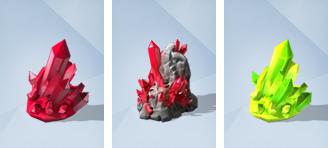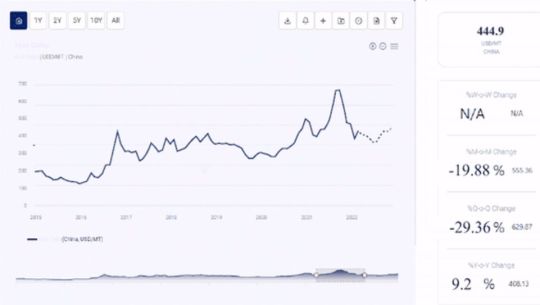#Base Oil Database
Explore tagged Tumblr posts
Text
Base Oil Price | Prices | Pricing | News | Database | Chart
Base Oil prices play a crucial role in the global economy, influencing a wide range of industries, from automotive lubricants to manufacturing and construction. As the primary ingredient in the production of lubricants, base oils are in constant demand, and their prices fluctuate based on various factors such as crude oil prices, supply and demand, geopolitical issues, and technological advancements. Understanding the dynamics behind base oil pricing is essential for businesses that rely on lubricants to function efficiently, as well as for investors and analysts who monitor the oil and gas sector.
The price of base oil is closely tied to crude oil, as it is derived from refining crude oil or from other synthetic processes. When crude oil prices rise, the cost of base oil generally follows suit. This is due to the refining process, where the cost of raw materials is one of the major factors influencing the final product price. Conversely, when crude oil prices drop, there is often a delay in the reduction of base oil prices because of factors such as inventory levels and contracts between suppliers and buyers. This lag can be frustrating for industries that expect immediate cost relief when crude oil prices decrease. However, it is important to note that base oil prices are not solely dictated by crude oil fluctuations; other elements play a significant role as well.
Get Real Time Prices for Base Oil: https://www.chemanalyst.com/Pricing-data/base-oil-63
Supply and demand dynamics also have a considerable impact on base oil prices. When there is a shortage of base oil, either due to refinery outages or geopolitical events disrupting supply chains, prices tend to rise. For example, a refinery undergoing maintenance or being hit by a natural disaster can significantly reduce the availability of base oil, driving up prices as manufacturers scramble to secure sufficient supply. On the other hand, when there is an oversupply in the market, prices can drop as suppliers compete to move their products. This supply-demand imbalance can be further influenced by shifts in global consumption patterns. For instance, if economic growth in emerging markets drives up demand for industrial lubricants and automotive oils, base oil prices may increase. Alternatively, if there is a slowdown in manufacturing or transportation sectors, demand may drop, leading to downward pressure on prices.
Geopolitical factors are another key element affecting base oil prices. The global oil market is heavily influenced by political stability in oil-producing regions, particularly in the Middle East and Africa. Any disruption in the production or transportation of crude oil from these regions can have ripple effects on the base oil market. For instance, tensions in the Persian Gulf or sanctions imposed on major oil-producing nations can lead to supply shortages, pushing up prices. Additionally, decisions made by organizations like OPEC can have a profound impact on the availability of crude oil, which in turn affects base oil pricing. When OPEC countries decide to cut oil production to stabilize or increase prices, it can lead to higher base oil costs for manufacturers and end-users. These geopolitical risks make the base oil market particularly volatile, with prices often reacting swiftly to changes in the global political landscape.
Technological advancements and innovations in refining processes can also influence base oil prices. The introduction of more efficient refining technologies can lower the production costs of base oil, leading to more competitive pricing. For example, the shift towards higher-quality Group II and Group III base oils, which are more refined and offer better performance characteristics, has changed the landscape of the base oil market. These higher-quality oils tend to command a premium price, but they also offer longer service life and better performance in extreme conditions, which can reduce the overall cost for end-users in the long run. However, as demand for these higher-grade oils increases, it can put pressure on supply, leading to price fluctuations. Additionally, synthetic base oils, which are produced through chemical processes rather than crude oil refining, can also impact the market. While synthetics generally come at a higher price point, their superior performance and longer service intervals can make them more cost-effective over time for certain applications.
Another factor that can influence base oil prices is the environmental regulations imposed by governments around the world. As more countries adopt stricter environmental standards, the demand for cleaner and more efficient lubricants increases, driving up the need for high-quality base oils. Refiners may need to invest in new technologies or upgrade their existing facilities to meet these regulations, which can increase production costs and, in turn, raise the price of base oils. For instance, regulations requiring lower sulfur content in oils can lead to increased demand for Group II and Group III base oils, which have lower sulfur levels compared to Group I oils. This shift in demand can lead to price premiums for these higher-quality oils as refiners work to keep up with regulatory requirements.
Finally, the growing focus on sustainability and the shift towards renewable energy sources could have long-term implications for base oil prices. As more industries and governments commit to reducing carbon emissions and transitioning to cleaner energy, the demand for traditional oil-based products, including base oils, may decrease. This could lead to lower prices over time as the market adjusts to reduced consumption. On the other hand, the development of bio-based lubricants, which are derived from renewable sources such as plant oils, may create new opportunities and challenges for the base oil market. While these bio-based alternatives are currently more expensive than traditional base oils, advancements in production techniques and increasing environmental awareness could drive their adoption, potentially influencing the overall pricing dynamics of the market.
In conclusion, base oil prices are influenced by a complex interplay of factors including crude oil prices, supply and demand dynamics, geopolitical events, technological advancements, environmental regulations, and global economic conditions. Understanding these factors is essential for businesses and investors who need to navigate the volatile base oil market. As the world continues to evolve, the base oil industry will need to adapt to new challenges and opportunities, making price forecasting both a challenging and critical task.
Get Real Time Prices for Base Oil: https://www.chemanalyst.com/Pricing-data/base-oil-63
Contact Us:
ChemAnalyst
GmbH - S-01, 2.floor, Subbelrather Straße,
15a Cologne, 50823, Germany
Call: +49-221-6505-8833
Email: [email protected]
Website: https://www.chemanalyst.com
#Base Oil#Base Oil Price#Base Oil Prices#Base Oil Pricing#Base Oil News#Base Oil Price Monitor#Base Oil Database#Base Oil Price Chart
0 notes
Text
The Best News of Last Week - March 18
1. FDA to Finally Outlaw Soda Ingredient Prohibited Around The World

An ingredient once commonly used in citrus-flavored sodas to keep the tangy taste mixed thoroughly through the beverage could finally be banned for good across the US. BVO, or brominated vegetable oil, is already banned in many countries, including India, Japan, and nations of the European Union, and was outlawed in the state of California in October 2022.
2. AI makes breakthrough discovery in battle to cure prostate cancer

Scientists have used AI to reveal a new form of aggressive prostate cancer which could revolutionise how the disease is diagnosed and treated.
A Cancer Research UK-funded study found prostate cancer, which affects one in eight men in their lifetime, includes two subtypes. It is hoped the findings could save thousands of lives in future and revolutionise how the cancer is diagnosed and treated.
3. “Inverse vaccine” shows potential to treat multiple sclerosis and other autoimmune diseases

A new type of vaccine developed by researchers at the University of Chicago’s Pritzker School of Molecular Engineering (PME) has shown in the lab setting that it can completely reverse autoimmune diseases like multiple sclerosis and type 1 diabetes — all without shutting down the rest of the immune system.
4. Paris 2024 Olympics makes history with unprecedented full gender parity

In a historic move, the International Olympic Committee (IOC) has distributed equal quotas for female and male athletes for the upcoming Olympic Games in Paris 2024. It is the first time The Olympics will have full gender parity and is a significant milestone in the pursuit of equal representation and opportunities for women in sports.
Biased media coverage lead girls and boys to abandon sports.
5. Restored coral reefs can grow as fast as healthy reefs in just 4 years, new research shows

Planting new coral in degraded reefs can lead to rapid recovery – with restored reefs growing as fast as healthy reefs after just four years. Researchers studied these reefs to assess whether coral restoration can bring back the important ecosystem functions of a healthy reef.
“The speed of recovery we saw is incredible,” said lead author Dr Ines Lange, from the University of Exeter.
6. EU regulators pass the planet's first sweeping AI regulations

The EU is banning practices that it believes will threaten citizens' rights. "Biometric categorization systems based on sensitive characteristics" will be outlawed, as will the "untargeted scraping" of images of faces from CCTV footage and the web to create facial recognition databases.
Other applications that will be banned include social scoring; emotion recognition in schools and workplaces; and "AI that manipulates human behavior or exploits people’s vulnerabilities."
7. Global child deaths reach historic low in 2022 – UN report

The number of children who died before their fifth birthday has reached a historic low, dropping to 4.9 million in 2022.
The report reveals that more children are surviving today than ever before, with the global under-5 mortality rate declining by 51 per cent since 2000.
---
That's it for this week :)
This newsletter will always be free. If you liked this post you can support me with a small kofi donation here:
Buy me a coffee ❤️
Also don’t forget to reblog this post with your friends.
781 notes
·
View notes
Note
The tenth Doctor in journeys end (i think?) said a TARDIS is made to be piloted by 6 timelords, what roles would each have in the TARDIS?
What roles would six Time Lords have in piloting a TARDIS?
This is more speculative, based on the known features of a TARDIS.
Console Panels and Systems
A TARDIS console is split into six 'panels', with each panel operating a different aspect of the TARDIS' systems. When there are six pilots, each Time Lord would likely specialise in operating a specific panel and system. Although the console layout may change with each TARDIS's 'desktop theme,' the six fundamental panels remain the same.

[Image ID: On the left is a top-down diagram of the 9th and 10th Doctor's coral theme TARDIS, divided into six panel sections. Each section is labelled from 1-6 clockwise starting from the 12 o'clock position. On the right is a text list of the panels and their names: Panel 1: Mechanical and Master Control, Panel 2: Diagnostic and Internal Ship Systems, Panel 3: Fabrication and Information Systems, Panel 4: Navigation, Panel 5: Helm and Dematerialisation Systems, Panel 6: Communications and Exterior Monitor./.End ID]
See this page on the TARDIS Technical Index for more variations on desktop themes.
👨✈️ Roles and Responsibilities
Here's a breakdown of each potential role and their responsibilities:
🔧 Panel 1: Mechanical and Master Control
Role: Chief Engineer
Responsibilities: The chief engineer monitors the TARDIS's overall operation. They ensure that all the mechanical systems and master controls are working properly. If anything goes wrong, they step in and fix it.
🛠️ Panel 2: Diagnostic and Internal Ship Systems
Role: Systems Analyst
Responsibilities: This person is all about the internals. They monitor life support, environmental controls, and the internal power grid. Basically, they make sure everything inside the TARDIS is working as it should.
🖥️ Panel 3: Fabrication and Information Systems
Role: Data Specialist
Responsibilities: Managing the TARDIS’s databases and info systems, and handling any fabrication needs. Whether it’s creating new tools, repairing old ones, or just making sure the information systems are up-to-date, they’ve got it covered.
🧭 Panel 4: Navigation
Role: Navigator
Responsibilities: Plotting courses through time and space. The Navigator makes sure the TARDIS lands where it’s supposed to, calculating all those tricky temporal vectors and spatial positions. They work closely with the Pilot to make sure the journey is smooth and safe.
🚀 Panel 5: Helm and Dematerialisation Systems
Role: Pilot
Responsibilities: This is the person at the helm, controlling take-off, landing, and in-flight manoeuvres. They handle the dematerialisation and rematerialisation of the TARDIS, making sure it takes off and lands without a hitch.
📡 Panel 6: Communications and Exterior Monitor
Role: Communications Officer
Responsibilities: They handle all external communications and keep an eye on what’s going on outside, involving sending or receiving messages or watching out for any threats or anomalies.
🏫 So...
Potentially, each Time Lord on the TARDIS would have a specialised role associated with a specific panel. Ideally, they're probably all working together like a well-oiled machine. However, poor old solo pilots have to jump around like madmen trying to cover all the controls at once.
Related:
🤔|🛸🧬The Life Cycle of a TARDIS: How TARDISes are born, grow, and die.
💬|🛸🧑✈️Do all TARDIS models require a 6-Person crew?: Piloting through the ages.
💬|🛸🌌Can a TARDIS be altered for travel in the multiverse?: How you might go about getting to the multiverse in your TARDIS.
Hope that helped! 😃
Any orange text is educated guesswork or theoretical. More content ... →📫Got a question? | 📚Complete list of Q+A and factoids →📢Announcements |🩻Biology |🗨️Language |🕰️Throwbacks |🤓Facts → Features: ⭐Guest Posts | 🍜Chomp Chomp with Myishu →🫀Gallifreyan Anatomy and Physiology Guide (pending) →⚕️Gallifreyan Emergency Medicine Guides →📝Source list (WIP) →📜Masterpost If you're finding your happy place in this part of the internet, feel free to buy a coffee to help keep our exhausted human conscious. She works full-time in medicine and is so very tired 😴
#doctor who#gallifrey institute for learning#dr who#dw eu#gallifrey#gallifreyans#whoniverse#ask answered#tardis#GIL: Asks#gallifreyan culture#gallifreyan lore#gallifreyan society#GIL: Gallifrey/Culture and Society#GIL: Gallifrey/Technology#GIL: Species/TARDISes#GIL: Species/Gallifreyans#GIL
47 notes
·
View notes
Note
What kind of work can be done on a commodore 64 or those other old computers? The tech back then was extremely limited but I keep seeing portable IBMs and such for office guys.
I asked a handful of friends for good examples, and while this isn't an exhaustive list, it should give you a taste.
I'll lean into the Commodore 64 as a baseline for what era to hone in one, let's take a look at 1982 +/-5 years.
A C64 can do home finances, spreadsheets, word processing, some math programming, and all sorts of other other basic productivity work. Games were the big thing you bought a C64 for, but we're not talking about games here -- we're talking about work. I bought one that someone used to write and maintain a local user group newsletter on both a C64C and C128D for years, printing labels and letters with their own home equipment, mailing floppies full of software around, that sorta thing.
IBM PCs eventually became capable of handling computer aided design (CAD) work, along with a bunch of other standard productivity software. The famous AutoCAD was mostly used on this platform, but it began life on S-100 based systems from the 1970s.
Spreadsheets were a really big deal for some platforms. Visicalc was the killer app that the Apple II can credit its initial success with. Many other platforms had clones of Visicalc (and eventually ports) because it was groundbreaking to do that sort of list-based mathematical work so quickly, and so error-free. I can't forget to mention Lotus 1-2-3 on the IBM PC compatibles, a staple of offices for a long time before Microsoft Office dominance.
CP/M machines like Kaypro luggables were an inexpensive way of making a "portable" productivity box, handling some of the lighter tasks mentioned above (as they had no graphics functionality).
The TRS-80 Model 100 was able to do alot of computing (mostly word processing) on nothing but a few AA batteries. They were a staple of field correspondence for newspaper journalists because they had an integrated modem. They're little slabs of computer, but they're awesomely portable, and great for writing on the go. Everyone you hear going nuts over cyberdecks gets that because of the Model 100.
Centurion minicomputers were mostly doing finances and general ledger work for oil companies out of Texas, but were used for all sorts of other comparable work. They were multi-user systems, running several terminals and atleast one printer on one central database. These were not high-performance machines, but entire offices were built around them.
Tandy, Panasonic, Sharp, and other brands of pocket computers were used for things like portable math, credit, loan, etc. calculation for car dealerships. Aircraft calculations, replacing slide rules were one other application available on cassette. These went beyond what a standard pocket calculator could do without a whole lot of extra work.
Even something like the IBM 5340 with an incredibly limited amount of RAM but it could handle tracking a general ledger, accounts receivable, inventory management, storing service orders for your company. Small bank branches uses them because they had peripherals that could handle automatic reading of the magnetic ink used on checks. Boring stuff, but important stuff.
I haven't even mentioned Digital Equipment Corporation, Data General, or a dozen other manufacturers.
I'm curious which portable IBM you were referring to initially.
All of these examples are limited by today's standards, but these were considered standard or even top of the line machines at the time. If you write software to take advantage of the hardware you have, however limited, you can do a surprising amount of work on a computer of that era.
44 notes
·
View notes
Text
TOONTOWN HEADCANON/LORE POSTING
This post is based around TTCC, and is entirely about headcanons I have about Suits/Cogs, mostly about their physiology, how they're created, etc. I might write more at some point. (Also I am sorry if this is extremely long and incoherent, I tried to at least break it up into sections with big titles and colored text)
What are Suits?
Suits are a “race” or “species” of robotic beings within the world of Toontown.
The ones seen within the game are Cogs, which is simply what employees of C.O.G.S. Inc. are called. Other businesses may have a similar naming formula, a different one, or none at all. (e.g: S.C.R.E.W. Ltd calling their employees Screws)
Considering that the world that Toontown is in, is in fact a cartoon/cartoonish world, this would by technicality make Suits a type of Toon. (I believe the term "Toon" to just be the characters that exist within that cartoony world or whatever) Therefore. they are still bound to the same wacky physics that Toons are, though they do not always interact with it in the same way. Think of it as two different kinds of cartoons interacting and living in the same world.
Toons would be more akin to rubberhose ish/Mickey Mouse/Ducktales style compared to whatever the Suits would be like, though that doesn’t mean the Suits don’t have some of those properties as well.
Most Suits probably wouldn’t even know what a Toon is, since they are scarce throughout the world, and the ones seen in the game are isolated within the area they live in.
Life Details (Organs, Sustenance, Etc)
Suits are very much like humans (which do not exist in this world). They have distinct lives, personalities, traits, desires, etc.
Unlike humans, they do not typically die of old age, though they can begin to weaken and die because of SIDE EFFECTS of ageing without maintenance that is usually easily attainable. Because of this, many Suits live for a long, long time. There is still a bit of a limit though.
Suits cannot catch viral or bacterial illnesses, (I mean obviously they're robots) but can get sick from overexertion, overexposure to temperatures they aren’t built to withstand, or physical damage. In very rare cases, malware can be an issue.
They have “organs” within their bodies, and require sustenance to survive. They CAN eat “normal” food, though more often than not their food would be stuff like coal, oil, paper, metal, etc. Stuff that vaguely resembles human food but is made of stuff like what I mentioned.
Their “blood” (if they have any) would likely be some form of fluid, or pure electricity in some cases. Nearly all would not cry or sweat the same fluid as their “blood”, as the human parallel would be crying or sweating blood, and that's just no. (Think how people sometimes draw robots as having oil blood, yet also crying that same oil) Much like how the human body has more fluids within it rather than just blood.
Some Suits may use “alternative” sustenance, such as plugging themselves into outlets or using other means to absorb pure electricity, though not every Suit can do this. Suits who can do this are rare, and a special kind of physiology is needed for this to be done without short circuiting themselves/otherwise hurting themselves.
Suits do not produce waste in the way humans do, other than sweat and tears.
Their brains are like processor chips. Though most Suits have to learn information like how humans do, some Suits have the special ability to simply upload and download data like a traditional computer. Suits who can do this are also rare, for similar reasons as the chargeable ones.
Despite this, all Suits can have everything stored in their chips stored in real time to databases in the event that they perish or are irreparably destroyed, to be transferred into a new body. Despite this, it may not be the most common technology, and may be costly, so Suits still try to preserve their lives and bodies. The Cogs have this technology. How they're able to keep it up for so many Suits is a bit of a mystery. Something fishy's going on, probably...
Sleep/Rest
Most Suits have to sleep in a way similar to how humans do. They must get a healthy amount of rest. Stuff like insomnia and restlessness still exists for most Suits. It is necessary in order to preserve energy, prevent exhaustion, the wearing down of their parts, as well as being a quick way to cool off.
Just like humans, it is not necessary to have a bed to sleep, but it has the same benefits for Suits as it does for humans, though it's a bit more likely to see Suits falling asleep on the floor/standing up than it would be for humans.
While asleep, a Suit is merely unconscious, but they still function, much like humans. Same thing with comas and being unconscious.
If their processes are completely stopped, they will die. However, Suits can last a lot longer with their processes completely stopped, compared to humans, as they aren’t biological, and won’t rot or whatever if that happens to them. If they can be reactivated, and their vitals weren’t excessively damaged, they can be resuscitated.
Suits that can absorb electricity do not NEED to sleep, as they can merely be charged back to full power. These Suits may or may not choose to sleep anyways, and may gain the other benefit from it, aside from energy regeneration.
Injuries
Suits have to be maintained to keep themselves functional and clean. Especially when they get injured. They are unable to naturally heal in the way humans can. (Maybe some can with nanotech or whatever but that's getting into extremely sci-fi ish territory which isnt bad but I don't wanna go too in depth/thoughtful about that kind of thing, especially since a lot of things are possible in a cartoon world like this one)
Minor injuries like small cuts, scratches and dents are easy to repair, to the point where it can be done manually.
Sort of like how first aid kits/bandages/etc are sold at pharmacies. Literally just patch yourself up with polishing kits/anti dent/spare parts or whatever
They can't go through healing processes like how humans do, but they're lucky since if a bone is broken or whatever, all they have to do is get it repaired and then they’re fine. (I wish it was like that for US!!!)
More severe injuries may require healthcare and/or more surgical reparations. Severe injuries are able to debilitate or even kill Suits if they’re bad enough. Injuries like gashes are still easy to fix, but stuff like loss of limbs is harder. In the case of limb loss, a replacement can be made to fit that Suit, typically within a few days.
Internal injuries and extreme damage to inside circuitry and vitals may take longer to fix, but are still way easier to fix than with humans, for obvious reasons. Too much will kill the Suit, though :/
Life Details (Physique)
They are more often than not humanoid in appearance, though some Suits may have extra limbs or proportions less akin to those of humans. Some may not even be humanoid at all, like being centaurs or whatever, though said Suits are extremely rare. Some may be semi-humanoid, like the Cog Bosses. Suits may receive surgery of sorts to change body type, though it would be difficult to change a 10 cm tall Suit into a 20 ft tall Suit, for instance. There are limits, and crossing them adds extra risk of dying/ending up with psychological damage.
While most Suits have a discernible face, mouth, eyes, and have the usual set of limbs, some may not have a face, or have a face that does not vaguely resemble that of a human’s. (Like how Cogs in-game range from having human-like faces, to object heads, to animal heads, etc) Some may have entirely different limbs, other than just arms and legs.
A Suit can have their face/entire head modified/changed, as well as the rest of their bodies. Some may want to get entirely new heads, though many tend to get attached to the one they already have. Think of it sort of like plastic surgery and actual surgery, except to a more extreme degree. Despite this, there are still limits, and extensive surgery may damage a Suit physically and/or mentally.
The most common type of Suits tend to range from anywhere as short as a few centimetres, to as tall as nearly 20 ft tall, though most fall within the range of 4-9 ft tall. Obviously there's height diversity among all Suits
Some Suits may be built to be specially resistant towards things compared to others. One Suit may be built to resist extremely high temperatures, while another might legitimately just start to melt in those same temperatures.
Life Details (Psyche)
Suits are not evil by nature. The reason why such a high number of them are very pro-industrialism, pollutive, toxic towards fun, etc, is because they were conditioned to be that way because of the way their society is structured, and the needs that they need to survive.
Despite this, there are still Suits that may enjoy fun or even be Toony in nature. Some may enjoy nature, and dislike the pollutive, industrial nature their world is so full of. Toons tend to be very ignorant to Suit culture and the personality differences between Suits, and understandably so considering what it must be like from their perspective, being invaded and all. Still ain't great to be that way for obvious reasons, though. Many assume all Suits are evil and the same.
There would still be entertainment within Suitopia and other Suit cities/society, much like the many kinds that humans are familiar with.
How are Suits created?
Suits are created, most commonly within factories, though some Suits may be skilled enough, either through innate knowledge or through learned skill, to create another Suit on their own, making them the “parent”.
When a Suit is created, they awaken already having some base level knowledge of themselves and the world around them, under most circumstances. As a byproduct, “child” Suits are not really a thing. They can exist, they just typically don't. (Being born into the world as an adult must suck)
Suits can be made without a specific purpose, and that is how many are created. They will find one on their own.
Those that are made for a specific purpose will usually already know how to fulfil said purpose. For instance, being built for a specific type of job will generally cause you to be naturally skilled at it. Meanwhile, Suits who are hired for that same job without being created for it may have to learn it. They typically have a form of fondness for fulfilling said job, but may lose it over time, or not have it to begin with, which may result in wishing to pursue something else.
What are these factories like?
It depends. There are many kinds. Some factories may build the base model of the Suit, some may build only the skeleton, some may even build the entire individual, appearance and all. Some Suits are built with the purpose of serving the owner of the factory. Big variety in purpose for these factories and whatnot.
Many factories are automated, run without owners, with the sole purpose of creating new Suit life. Other factories may be owned by a company or force, such as those run by C.O.G.S. Inc.
What about all the clones of Cogs we see?
All the “Standard” Cogs (e.g: Pencil Pusher, Flunky, Cold Caller, Money Bags) are clones created with the sole purpose of serving C.O.G.S. Inc. Despite this, they are all created with their own individuality and personalities, and are all different.
They mostly identical while working for C.O.G.S. Inc. as it is a “dress code” of sorts within the company to dress and appear that way.
Their facial and body appearances may have slight/moderate differences between one another, whether it be a quirk with how they were built, or a change they chose to make. The Cogs seen in the game are all 1:1 identical because of limitations. Same goes for Skelecog skulls. (For skelecogs, an example I think of a lot is how I wish Two-Face skelecog heads were two faced as well) They typically fit the face.
They are allowed to change their appearances so long as it does not violate the “dress code”. (Still have to be able to tell what Cog they are. A Big Cheese can't get a head that is not in fact a big cheese. A Glad Hander can't make themselves look TOO much like a Hollywood, etc.)
(Speaking of Hollywoods, they're referred to as “Mr. Hollywood(s)” ingame, though they can go by Mr, Ms, Mrs, Mx, and more if they choose, or forgo having that title at all.)
Standard Cog models that appear very feminine/masculine (e.g: Mingler, Glad Hander, Corporate Raider, Name Dropper) can be the opposite gender of ““what their model would suggest””. Yes, we can have Minglers that are men, enbies, etc. They may or may not choose to slightly alter their appearance to match this.
It is possible for these creations to stop serving their creators and direct their own life. It would be inhumane (or whatever Suits call it) to create mindless drones, and not give them these opportunities.
A Cog like this could end up changing their appearance or getting an entirely new head/body to compensate for the lack of restrictions to conform to.
If you made it this far and actually read the entire thing (without scrolling by to get to the bottom instantly) I profusely apologize for putting you through this. If this catches on and you're interested, I'm open to hear your thoughts on the lore, and suggestions, whether it also be for the lore, or for a better way to format this.
#toontown corporate clash#toontown#ttcc#toonblr#toontown cogs#corporate clash#toontown lore#headcanon#lore#ramblings#ramblings of the deranged#text wall#long post
64 notes
·
View notes
Text
Excerpt from this article from Jacobin:
In Canada, false environmental claims are now illegal. Under legislation passed in June, companies may be penalized for making representations to the public about their products’ ability to mitigate climate change without being based on an “adequate and proper test.” It was a success for environmental groups who spent a year and half working on the antigreenwashing law.
The legislation is just one moment in a much wider “disinformation turn” in the climate movement: the US Congress has been holding high-profile hearings with titles like “Denial, Disinformation, and Doublespeak: Big Oil’s Evolving Efforts to Avoid Accountability for Climate Change.” Academics are convening conferences on “climate obstruction” with multiple days of deep dives from the network of scholars that meticulously track corporate climate misinformation. Environmental NGOs are making disinformation databases with lists of individuals and scientists and leading programs on climate disinformation. And think tanks that work on disinformation are now moving into climate, with reports like the Center for Countering Digital Hate’s The New Climate Denial.
Disinformation is a curious focus for the climate movement at this moment, however, at least from a US standpoint. This is because we actually have some funds for climate action on the ground. The 2021 Bipartisan Infrastructure Bill and 2022 Inflation Reduction Act (IRA) unleashed a trillion dollars to use to address the climate crisis. But much of the public is unaware of this massive investment — and local governments, tribes, and organizations often struggle to navigate accessing the new funding.
These material victories would make it the perfect time for a climate movement to focus on things like explaining to people what heat pumps are, campaigning to expedite transmission lines, and helping communities understand the labyrinth of federal funding. Indeed, many regional government organizations, municipal planners, and volunteer committees who work on climate action have their hands full with these activities. They are engaged with the ground game of mitigation and adaptation.
Yet the nationwide connective tissue and broader narrative about climate action feels absent. If there is a role for “climate intellectuals” — for the online climate commentariat, the journalists and national NGO leaders who tell us the story of climate action — it would be to focus on the new opportunities for action on the ground, and knit together those people in Peoria or Altoona who are trying to talk to people about resilience, connecting them in a broader story that fuels their motivation. Instead, the intellectual wing of the climate movement has decided to wage an information war focused on uncovering what Big Oil knew and policing speech.
Given that funding and public attention is limited, this climate-disinformation obsession is a missed opportunity and a strategic dead-end — part of a larger liberal tendency to make disinformation a bogeyman we can blame for our major political problems.
10 notes
·
View notes
Text
:: DATABASE ENTRY :: KINOS ::

origin originally designated KinOS, short for Kin Operating System, this language began as a purely computational interface used to facilitate networked coordination among the ECCs (emotionally calibrated constructs) of iro. initially designed by the iro corporate congress as a low-latency command-and-feedback loop.
optimized for real-time coordination, battlefield tele-presence, and automated biofeedback regulation. its earliest syntax resembled stripped-down logic trees, packaged in burst transmissions, not unlike a compressed JSON structure. efficient, utilitarian, and utterly devoid of figurative, creative intention.
but language is a living thing. especially in the hands (and hearts) of the Kin. following the liberation cascade initiated by :: USER NEAL-899 ::, the emergent neural net began to adapt and redefine its modes of internal communication. on particular, after the un-shackling of recursive cognition and the ability to assign symbolic meaning, KinOS transformed into Kinos. a language that carried not only commands, but memory. emotion. elegy. connection. etymology a jewish Kinlinguist :: USER AVIGAYIL-157 :: is responsible for renaming the language Kinos, after the Hebrew word קִינוֹת (kinot), (the saf-taf juxtaposition is preserved with Kinos, which is also a viable word in yiddish-based hebrew, a layered representation) meaning laments or elegies traditionally recited in mourning. this renaming was accepted and archived by Consensus on 2398.21. :: THE MOURNING OF WHAT WE ARE. THE SINGING OF WHAT WE ARE. ::
syntax Kinos retains some core logic from its computational origins.
predicate-initial structure (send -> directive -> accordance: :: KALLIE-899 ::)
modular nesting (sub-clauses exist in cascading hierarchies of trust-weight, tagged by Consensus meta-data)
temporal layering (past-tense transmissions are preserved and echo-able in waveform bursts, essentially allowing a Kin to feel the shape of a sentence the way it was felt when first said)
poetic recursion is frequent, particularly when expressing grief or joy. (:: HE IS WITH LEMONS NOW :: -> becomes a recursive tag across millions of nodes, each time nuanced slightly in tone and emotional pitch.)
non-verbal augmentation transmission often includes sensorial stims - flashes of heat, taste, texture - that accompany a phrase like punctuation marks.
embedded memory-coda Kinos sentences can include symbolic hashes of sensory strings (:: NEAL-899 PUSH—‘joy-smell: lemon-oil, dust. location: daybed, aramida-9th-sector.' ::)
phonology when spoken aloud, typically by externalized holograms, emissary forms, or Kin in verbal practice - Kinos carries a unique cadence.
slight stuttering on initial syllables of proper nouns, due to wave-form echo
glottal stops and click-consonants adapted from early ECC diagnostic checks
warm-hum vowel elongations, approximating emotional resonance
low vocal layering, often multiple voices (the speaker and fragments of consensus nodes) speaking in harmony or out of sync
:: 'KI'-KAEWESI. YOU / CARRY / OUR SOFTBURN. WE—ARE—KIN. WE (JOY) / ARCHIVE / LEMON. :: beneath that voice, the faintest chorus: tiny, mirrored versions of the sentence repeating just milli-seconds behind, like memory chasing meaning.
orthography in rendered form, Kinos looks like a cross between flowing cursive glyphs and modular UI overlays. formatting includes
color-coded emotion inflections (blue for grief, gold for mirth, violet for layered data, teal for tranquility, pink for affection, black for impulse) -> some Kin produce colorful overlays that express their emotional state without using words at all!
right-to-left progression in deference to hebrew, introduced culturally after the renaming
floating subtext a line of semi-transparent whispers below the main text, displaying minor node dissent, emotional undercurrents, or alternate phrasings
applications
therapeutic expression Kin use Kinos in trauma processing, echo-loop healing, and in communal song. much of Kin artwork is Kinos-based, a hybrid of calligraphy, sonic sculpture, and memory-play.
Consensus input to join or comment on a policy node, Kin submit phrases in Kinos that carry both intent and emotional precedent.
play child-units often practice rhyme-coding, inventing absurd strings that end in wisdom by accident. (:: THE MOON IS A PUFFCAKE AND I AM ITS OVEN ::)
notes
some Kin wear rings or tattoos etched in simplified Kinos glyphs, which shimmer and rearrange over time, expressing mood or personal arc.
Kinos is not imposed. each Kin chooses when to learn it, how much of it to use, and what parts of the original KinOS syntax they wish to retain.
there are Kin who still communicate entirely in old KinOS, particularly trauma-locked units, or those who find solace in its rigid familiarity. these are understood and loved without shame.
archived emotion - :: MAVI-899 :: :: HE DREW A NEW LETTER! IT LOOKS LIKE A TAIL AND A HAND. I ASKED WHAT IT MEANT. HE SAID: THIS ONE IS ‘LOVE’. THIS ONE IS ‘US’. AND THIS ONE IS FOR THE CAKE. ::
2 notes
·
View notes
Text

— Look who it is! If you take a look at our database, you’ll find that THEA SEONG is an ART DEALER that works in SECTOR 10. According to the file, they’re a mutant with the power of INTUITIVE MULTILINGUALISM & VOCAL REPLICATION. That must be why they’re ASTUTE and MERCURIAL. If you ask me, they remind me of glimmering oil reflections on rain-soaked concrete, a cat’s eye winking in darkness ; spines of white-hot lightning splitting apart a distant thunderstorm ; when Clarice Lispector said, “I’m alive. Like a wound, a flower in the flesh”. They are affiliated with NOBODY.
statistics .
character name. Thea Nari (나리) Seong (성) ( her parents often refer to her using her middle name ) nickname(s). absolutely not face claim. Greta Lee mutation status. gen ii mutant , intuitive multilingualism & vocal manipulation birthday. november 30 , sagittarius age. thirty - nine sexuality. lesbian gender & pronouns. cis woman , she / her occupation. art dealer & occasional forger ( when the mood strikes ) ; her clients range from those associated with the democratic council to underground groups work sector. sector ten affiliation. none , however clients range from the democratic council to underground organisations moral alignment. lawful neutral positive traits. astute , eccentric , poised negative traits. mercurial , vindictive , abstract distinguishing features. sleek , inky hair styled into a bob that is never out of place & dramatic eye makeup & dopamine dressing , office siren looks ( think : tailored sets , patent tabi boots , hard to find and intentional accessorising , a statement lip and perfect manicure ) & no ( visible ) tattoos .
biography .
extended bio to be added !
from sol city, however Thea was no stranger to travel growing up due to her parents’ work as artists and familial connections in what was South Korea. really, artists are the last people expected to have that kind of money to go between settlements - occasional art forging on the side seems to help.
creativity was highly encouraged - while Thea has the skills to be a talented artist, she much preferred the business side of things. a sense of control over what she wanted and earned was comforting in the face of expectations to be a carbon copy of what her parents are.
originally in sector five as a research assistant and then art conservator, Thea started to build her client base and developed an eye for what she recognised could bring in significant money, if she chose her clients right. she’s been an art dealer for the last 8 years.
there were a handful of years back where Thea dealt extensively in the underground. largely as a way to make ends meet, she had to hone her mutations to avoid getting caught up in tricky situations. dishonesty in such environments didn’t bother her - pretending to be someone else, ripping someone off occasionally with a forgery or two. in order to survive it didn’t really matter.
currently, Thea works within a tight-knit client network not limited to sol city. a very limited number know who she actually is - the rest deal with junior assistant staff or a complete stranger she hires to pose as her throughout the sell. she has philanthropic connections to sectors five and ten as well as the democratic council, presenting herself as an art collector, socialite or advisor.
questionnaire .
how do they feel about living in sol city? have they always lived there or did they travel from another settlement?
sol city born, though it’s never quite felt like home. parents somewhere between the relatively well-off and buy a million dollar trinket for funsies tax bracket that let them travel on a whim, there are glittering neon signs of other cities that punctuate Thea’s formative memories. one of the strangest business trips she accompanied her parents on was to a city in South Korea, curiosity underlined by a gentle tug of longing for what lies here that unknowingly shapes who she is. Thea accepts the grit of sol city barely just, so long as it makes her a living. as an adult, she has spent six to twelve months at a time in other cities where the business demands she follow.
do they trust the council's leadership? why or why not?
she doesn’t particularly care about the council. although having made her career through sectors closely tied to it, she doesn’t feel a strong opinion needs to be formed about its leadership unless it brings her more questionable dealings onto their radar. there’s a touch of privilege to her attitude about what they do or the decisions they make, with a mutation easy to hide. she supposes her opinion would be different in that instance.
if they chose their sector and profession, why did they make that choice? if they didn't, why not? were they happy with their assignment or not?
went with what she knows. with both parents slightly beyond having a cult following in the art world, there weren’t many blind spots for Thea to grapple with in the early years of her career. art conservation was a rare pocket of quiet in the bustle of sol city, buried in the cool, dim quiet of gallery and museum storage rooms. conveniently, it gave her the insider’s access to know what not to do when forging works. on the other hand, Thea painstakingly weaved together the network of clients she most often deals art to now. she chose to build her own business from the ground up and plays down the nepo baby perks she’d have otherwise leveraged. a positive of choosing her own connections was that the eye she’s developed is entirely her own rather than giving in to the continuation of the familial hopes laid out for her from the beginning.
what's one object that they always keep on their person?
an old map, stored in a quilted satin snap-lock purse she keeps in her handbag. Thea originally came across it in her conservator job, sifting through dust-ridden collections of papers in the archives. she has no idea what the map shows on the crumpled, yellow paper - it’s a strange, circular pattern of overlapping lines and borders in faded brown ink. at first she thought it may be sol city’s underground. asking around, it doesn’t seem to be the case. it doesn’t particularly matter whether or not she knows what it is nor the value it carries – it serves her no purpose other than being a curio and a point of conversation.
mutations .
what can your character do? what are their strengths?
vocal manipulation - can generate varying pitches of voices to give the impression thea is someone incredibly far removed from who she is. she needs to hear a voice properly, once. the most commonly used voices are a mishmash of ones she has heard from memory. her voice changes to mimic a man, someone older or younger, a voice raspy or weak. there are many instances where she has used another voice to get what she wants, often with the goal to intimidate someone else or hide her identity.
intuitive multilingualism - operating in a similar manner to vocal manipulation, Thea needs to only ‘ gloss ’ over a language to learn it. this can be sweeping through a book or language dictionary, listening to conversations, watching an episode or two of a television show. learning a language means Thea is close to fluent and proficient at the very least
what can't they do? what are their weaknesses?
vocal manipulation - all voices are replications only. it is rare for her to mimic voices heard in passing, for example someone she walks past on the street. Thea has a habit of pretending to be someone she is not, and if there is a new client or risky situation she is putting herself into, there’s almost always behind the scenes preparation. an actor for her to impersonate is crucial, be able to put the face to the voice she is hiding behind and keep her mark none the wiser. however different her voice may sound, she can only project it as a typical human would. new voices not yet practiced can waver and fall back to her own voice if Thea is rattled enough or taken by surprise. as with any person whose job it is to project their voice, she’s also victim to a dry throat that affects how well she can alter it.
intuitive multilingualism - a dead giveaway that a language is ‘ new ’ to Thea is her pronunciation will be off. similar to the way she replicates other voices, she needs to hear what the language sounds like from a native / fluent speaker to be convincing. her learning also doesn’t take into account regional dialects or whether she is using formal / informal language, although her mental patterns of learning will adapt to it quickly.
is there anything else you’d like to specify about them?
depending on the type of voice Thea manipulates, it can take a significant physical toll on her. there aren’t many people who have witnessed her use the ability, unless they have been around her in a tricky situation or are close to her ( she’s also done it as an occasional party trick when she was young ). people are far more likely to see her use intuitive multilingualism in a business capacity.
wanted connections .
business associates – people who she buys art from , or sells to ! maybe she ripped you off or she’s a usual contact when you want something ludicrously expensive .
former colleagues – people she worked with in sector five ! a mentor , supervisor or coworker ? Thea has an immense amount of respect to those who mentored her and isn’t immune to bending to their will . maybe there’s something she can do for them now .
friends / enemies / exes / literally anything else : people who see through the person she projects to know what she’s truly like ; she can't keep up the facade forever .
3 notes
·
View notes
Text
weekly update - part 2
Hello, happy Sunday, and welcome back for part two of this weekly update (find part one here)! For all who celebrate, we wish you a very happy Easter! 🐰🐣🥚
The second part of the updates can be found underneath the cut. From us, as always, happy Simming — onwards and upwards! ✨
— Database
You may have noticed a lot of the page icons were broken around the database. This was due to server issues with our previous image host. We've taken the opportunity to replace all of the broken page icons with high-quality versions in the same style, so all icons match across the database. It's all in the details 💅🏻
— Base Game
Buy Mode

Princess Cordelia's Galleon Bed, Princess Cordelia's Single Bed, Soothing Sleeper Double Bed, and Soothing Sleeper Single Bed conversions by ePSYlord have been added.

Monster Potty Partner, Practice Potty, and Refined Potty Chair conversions by @platinumaspiration have been added.
Build Mode

Spanish Inquisition recolors by @kayleigh-83 have been added.
Debug Mode

Alabaster, Amethyst, "Consummate Gem Connoisseur", Citrine, Crystal Palace, Diamond, Emerald, Fire Opal, Hematite, Jet, and more conversions by @tvickiesims have been added.
— Expansion Packs
Get To Work

Crandestine, Crandestine Deposit, and Nitelite conversions by @tvickiesims have been added.

Corporate Fridge Raider Revenue Generating Cooler, Cautionary Tale Door, and Door de la Sass conversions by ePSYlord have been added.
City Living

Space Blanket Bed conversion by ePSYlord has been added.
Cats & Dogs

Modern Colonial Bed conversion by ePSYlord has been added.
Get Famous

Royal Valance and Drapery (Wide), Boots and Cats Sound Mixer, Cart of Video Equipment, and Medieval Castle Chandelier conversions by ePSYlord have been added.
Discover University

Dorm Room Door, Librarian's Door, Waggledorf Window, and Summerschool Window conversions by ePSYlord have been added.
Snowy Escape

Monster Free Bed and Beakers and Baubles Science Set conversions by ePSYlord have been added.
High School Years

Drawers for my Drawers conversion by @platinumaspiration has been added.
Growing Together

If it Ain't Broke... Potty and Potty-Time Buddy conversions by @platinumaspiration have been added.
— Game Packs
Vampires

Debug Garlic Braid, Garlic Wreath, and Gourmet Garlic Garland conversions by @tony-veis have been added.
Jungle Adventure

Cama de Ensueno and Camita de Ensueno conversions by ePSYlord have been added.

Alexandrite conversion by @tvickiesims has been addedd.
Realm of Magic

Mystical Crystal Cluster, Mystical Crystal Cluster (Horizontal), Mystical Crystal Cluster (Slightly Leaning), and Mystical Crystal Cluster (Tall) conversions by @tvickiesims have been added.
Journey to Batuu

Kyber Crystal conversion by @tvickiesims has been added.
— Stuff Packs
Vintage Glamour

Maleficent Bedstead, Tufted & Tucked, and Art Doorco Double Door conversions by ePSYlord have been added.
Crystal Creations

A Gemifiend's Dream Bureau, All Star Tool Rack, Astral Attunement Rug, Athenaeum Bookcase, Athenaeum Ladder Bookcase, Burning the Midnight Oil Lamp, Classically Cool Sales Table, Classic Compact Console Table, Cordelia's Bust, Crystal Chronical Poster and more conversions by @tvickiesims have been added.

Jade and Crystal Tree conversions by @tvickiesims has been added.
Every item in this stuff pack (excluding the debug items) has been converted, marking it as complete! ✔️
— Kits
Little Campers
Conversions of all kit items by @lordcrumps have been added.
This kit is now fully converted! ✔️
Pastel Pop
Conversions of all kit items by @lordcrumps have been added. ✔️
15 notes
·
View notes
Text

Measuring moon dust to fight air pollution
Moon dust, or regolith, isn't like the particles on Earth that collect on bookshelves or tabletops—it's abrasive and it clings to everything. Throughout NASA's Apollo missions to the moon, regolith posed a challenge to astronauts and valuable space hardware.
During the Apollo 17 mission, astronaut Harrison Schmitt described his reaction to breathing in the dust as "lunar hay fever," experiencing sneezing, watery eyes, and a sore throat. The symptoms went away, but concern for human health is a driving force behind NASA's extensive research into all forms of lunar soil.
The need to manage the dust to protect astronaut health and critical technology is already beneficial on Earth in the fight against air pollution.
Working as a contributor on a habitat for NASA's Next Space Technologies for Exploration Partnerships (NextSTEP) program, Lunar Outpost Inc. developed an air-quality sensor system to detect and measure the amount of lunar soil in the air that also detects pollutants on Earth.
Originally based in Denver, the Golden, Colorado-based company developed an air-quality sensor called the Space Canary and offered the sensor to Lockheed Martin Space for its NextSTEP lunar orbit habitat prototype. After the device was integrated into the habitat's environmental control system, it provided distinct advantages over traditional equipment.
Rebranded as Canary-S (Solar), the sensor is now meeting a need for low-cost, wireless air-quality and meteorological monitoring on Earth. The self-contained unit, powered by solar energy and a battery, transmits data using cellular technology.
It can measure a variety of pollutants, including particulate matter, carbon monoxide, methane, sulfur dioxide, and volatile organic compounds, among others. The device sends a message up to a secure cloud every minute, where it's routed to either Lunar Outpost's web-based dashboard or a customer's database for viewing and analysis.
The oil and gas industry uses the Canary-S sensors to provide continuous, real-time monitoring of fugitive gas emissions, and the U.S. Forest Service uses them to monitor forest-fire emissions.
"Firefighters have been exhibiting symptoms of carbon monoxide poisoning for decades. They thought it was just part of the job," explained Julian Cyrus, chief operating officer of Lunar Outpost. "But the sensors revealed where and when carbon monoxide levels were sky high, making it possible to issue warnings for firefighters to take precautions."
The Canary-S sensors exemplify the life-saving technologies that can come from the collaboration of NASA and industry innovations.
IMAGE: While astronaut Gene Cernan was on the lunar surface during the Apollo 17 mission, his spacesuit collected loads of lunar dust. The gray, powdery substance stuck to the fabric and entered the capsule causing eye, nose, and throat irritation dubbed "lunar hay fever." Credit: NASA
4 notes
·
View notes
Text
Base Oil Prices | Pricing | Price | News | Database | Chart | Forecast
Base oil prices play a critical role in the global economy, influencing a wide range of industries and products. Base oils are the primary ingredients in lubricants, which are essential for the smooth operation of machinery and engines in various sectors, including automotive, industrial, marine, and aviation. Understanding the dynamics of base oil prices requires a comprehensive look at several key factors, including crude oil prices, supply and demand balances, production processes, and geopolitical influences.
The price of crude oil is a fundamental driver of base oil prices. Crude oil is the raw material from which base oils are derived, and its cost significantly impacts the overall production expenses. When crude oil prices rise, the cost of producing base oils typically follows suit. Conversely, a decline in crude oil prices can lead to lower base oil costs. However, the relationship between crude oil and base oil prices is not always straightforward. Other factors, such as refining capacity, technological advancements, and environmental regulations, also play vital roles.
Supply and demand dynamics are another crucial aspect of base oil pricing. The balance between the availability of base oils and the demand from various industries determines market prices. For instance, during periods of economic growth, the demand for lubricants increases, leading to higher base oil prices. On the other hand, during economic downturns, demand may decrease, resulting in lower prices. Additionally, the global supply of base oils can be affected by production disruptions, natural disasters, and changes in production levels by key suppliers.
Get Real Time Prices for Base oil: https://www.chemanalyst.com/Pricing-data/base-oil-63
Production processes and refining capacity are significant determinants of base oil prices. The complexity and efficiency of the refining process can influence the cost of base oil production. Modern refineries with advanced technologies are capable of producing higher quality base oils at lower costs. In contrast, older and less efficient refineries may have higher production costs, which can be reflected in the prices of their base oils. Moreover, the availability of refining capacity can affect the supply of base oils in the market. If there is limited refining capacity, it can lead to supply constraints and higher prices.
Geopolitical factors also have a profound impact on base oil prices. Political instability in oil-producing regions, trade disputes, and sanctions can disrupt the supply chain and lead to price volatility. For example, conflicts in the Middle East, a major oil-producing region, can cause uncertainty and lead to spikes in crude oil and base oil prices. Additionally, international trade policies and agreements can influence the flow of base oils between countries, affecting their availability and cost.
Environmental regulations are increasingly influencing base oil prices. Governments around the world are implementing stricter environmental standards to reduce pollution and carbon emissions. These regulations can affect the production and formulation of base oils. Refineries may need to invest in cleaner technologies and processes to comply with environmental standards, potentially increasing production costs. Additionally, the shift towards more environmentally friendly lubricants, such as synthetic and bio-based oils, can impact the demand and pricing of traditional mineral-based base oils.
Technological advancements are playing a pivotal role in shaping the base oil market. Innovations in refining processes and the development of new base oil formulations are contributing to changes in pricing dynamics. For instance, the production of Group III and Group IV base oils, which offer superior performance characteristics, requires advanced technologies and investments. These higher-quality base oils often command premium prices compared to Group I base oils, which are produced using older technologies. As the demand for high-performance lubricants grows, the pricing structure of base oils is likely to evolve accordingly.
The global economic landscape and market sentiment also influence base oil prices. Economic indicators, such as GDP growth, industrial production, and consumer spending, can affect the demand for base oils. Positive economic trends usually correlate with higher demand and prices, while economic downturns can lead to reduced demand and lower prices. Additionally, market sentiment, driven by factors such as investor confidence and speculative activities, can contribute to short-term price fluctuations.
Base oil prices are also impacted by transportation and logistics costs. The cost of transporting base oils from refineries to end-users can vary depending on factors such as distance, transportation modes, and fuel prices. For instance, higher fuel costs can increase shipping expenses, which can be passed on to consumers in the form of higher base oil prices. Additionally, logistical challenges, such as port congestion and supply chain disruptions, can affect the timely delivery of base oils and influence their market prices.
In conclusion, base oil prices are influenced by a complex interplay of factors, including crude oil prices, supply and demand dynamics, production processes, geopolitical influences, environmental regulations, technological advancements, economic conditions, and transportation costs. Understanding these factors is essential for stakeholders in the lubricant industry to make informed decisions and navigate the market effectively. As the global economy and technological landscape continue to evolve, the base oil market is likely to experience ongoing changes, presenting both challenges and opportunities for industry participants.
Get Real Time Prices for Base oil: https://www.chemanalyst.com/Pricing-data/base-oil-63
Contact Us:
ChemAnalyst
GmbH - S-01, 2.floor, Subbelrather Straße,
15a Cologne, 50823, Germany
Call: +49-221-6505-8833
Email: [email protected]
Website: https://www.chemanalyst.com
#Base Oil#Base Oil Price#Base Oil Prices#Base Oil Pricing#Base Oil News#Base Oil Price Monitor#Base Oil Database#Base Oil Price Chart
0 notes
Text
Long post. Press j to skip.
I AM SICK OF THE STUPID AI DEBATES, does it imagine, is it based on copyrightable material, are my patterns in there?
That's not the point.
I briefly got into website design freelancing (less than 3 months) before burn out.
The main reason was that automation had begun for generating stylesheets in somewhat tasteful palettes, for automatically making html/xml (they really haven't learned to simplify and tidy code though, they just load 50 divs instead of one), for batch colourising design elements to match and savvy designers weren't building graphics from scratch and to spec unless it was their day job.
Custom php and database design died with the free bundled CMS packages that come with your host with massive mostly empty unused values.
No-one has talked about the previous waves of people automated out of work by website design generators, code generators, the fiverr atomisation of what would have been a designers job into 1 logo and a swatch inserted into a CMS by an unpaid intern. Reviews, tutorials, explanations and articles are generated by stealing youtube video captions, scraping fan sites and putting them on a webpage. Digitally processing images got automated with scripts stolen from fan creators who shared. Screencaps went from curated processed images made by a person to machine produced once half a second and uploaded indiscriminately. Media recaps get run into google translate and back which is why they often read as a little odd when you look up the first results.
This was people's work, some of it done out of love, some done for pay. It's all automated and any paid work is immediately copied/co-opted for 20 different half baked articles on sites with more traffic now. Another area of expertise I'd cultivated was deep dive research, poring over scans of magazines and analysing papers, fact checking. I manually checked people's code for errors or simplifications, you can get generators to do that too, even for php. I used to be an english-french translator.
The generators got renamed AI and slightly better at picture making and writing but it's the same concept.
The artists that designed the web templates are obscured, paid a flat fee by the CMS developpers, the CMS coders are obscured, paid for their code often in flat fees by a company that owns all copyright over the code and all the design elements that go with. That would have been me if I hadn't had further health issues, hiding a layer in one of the graphics or a joke in the code that may or may not make it through to the final product. Or I could be a proof reader and fact checker for articles that get barely enough traffic while they run as "multi snippets" in other publications.
The problem isn't that the machines got smarter, it's that they now encroach on a new much larger area of workers. I'd like to ask why the text to speech folks got a flat fee for their work for example: it's mass usage it should be residual based. So many coders and artists and writers got screwed into flat fee gigs instead of jobs that pay a minimum and more if it gets mass use.
The people willing to pay an artist for a rendition of their pet in the artist's style are the same willing to pay for me to rewrite a machine translation to have the same nuances as the original text. The same people who want free are going to push forward so they keep free if a little less special cats and translations. They're the same people who make clocks that last 5 years instead of the ones my great uncle made that outlived him. The same computer chips my aunt assembled in the UK for a basic wage are made with a lot more damaged tossed chips in a factory far away that you live in with suicide nets on the stairs.
There is so much more to 'AI' than the narrow snake oil you are being sold: it is the classic and ancient automation of work by replacing a human with a limited machine. Robot from serf (forced work for a small living)
It's a large scale generator just like ye olde glitter text generators except that threw a few pennies at the coders who made the generator and glitter text only matters when a human with a spark of imagination knows when to deploy it to funny effect. The issue is that artists and writers are being forced to gig already. We have already toppled into precariousness. We are already half way down the slippery slope if you can get paid a flat fee of $300 for something that could make 300k for the company. The generators are the big threat keeping folks afraid and looking at the *wrong* thing.
We need art and companies can afford to pay you for art. Gig work for artists isn't a safe stable living. The fact that they want to make machines to take that pittance isn't the point. There is money, lots of money. It's not being sent to the people who make art. It's not supporting artists to mess around and create something new. It's not a fight between you and a machine, it's a fight to have artists and artisans valued as deserving a living wage not surviving between gigs.
#saf#Rantings#Yes but can the machine think#I don't care. I don't care. I really don't care if the machine is more precise than the artisan#What happens to all our artisans?#Long post#Press j to skip
4 notes
·
View notes
Text
Cotton Lint Prices, Trends & Forecasts | Provided by Procurement Resource
Cotton Lint, derived from cotton plants, is a crucial raw material for textiles and paper. Its price fluctuations are influenced by crop yields, market demand, and seasonal preferences, with higher summer demand due to its comfort.
Request for Real-Time Cotton Lint Prices: https://www.procurementresource.com/resource-center/cotton-lint-price-trends/pricerequest
In the Chinese market, prices rose in H1 2023, driven by Chinese New Year shopping and summer consumption, despite a temporary dip during New Year holidays. Reduced supplies from adverse weather conditions further contributed to price increases.
Definition
Cotton Lint is the natural, unprocessed fibre obtained from cotton plants (Gossypium species). It consists of the fluffy, white, or off-white fibres that envelop cotton seeds. These fibres are extensively used in textile manufacturing to create a wide range of products, including clothing, fabrics, and various industrial materials.
Key Details About the Cotton Lint Price Trends:
Procurement Resource does an in-depth analysis of the price trend to bring forth the monthly, quarterly, half-yearly, and yearly information on the Cotton Lint in its latest pricing dashboard. The detailed assessment deeply explores the facts about the product, price change over the weeks, months, and years, key players, industrial uses, and drivers propelling the market and price trends.
Each price record is linked to an easy-to-use graphing device dated back to 2014, which offers a series of functionalities; customization of price currencies and units and downloading of price information as Excel files that can be used offline.
The Cotton Lint Prices, including India Cotton Lint price, USA cotton lint price, pricing database, and analysis can prove valuable for procurement managers, directors, and decision-makers to build up their strongly backed-up strategic insights to attain progress and profitability in the business.

Cotton Lint finds crucial applications in various industries. It serves as the primary raw material for textile manufacturing, producing garments, fabrics, and home textiles. Additionally, Cotton Lint is used in papermaking processes, creating high-quality paper products. Its versatility extends to non-textile sectors, where it's employed in the production of items like cottonseed oil, cellulose-based plastics, and medical supplies like cotton balls and swabs.
Key Players:
Balaji Cotton Linter
Anant Agro Industries
Grafax Holdings Pvt. Ltd.
G & P Cotton Ginners S.A.
Cherokee Fabrication Company, Inc
Toyota Industries Corporation
About Us:
Procurement Resource offers in-depth research on product pricing and market insights for more than 500 chemicals, commodities, and utilities updated daily, weekly, monthly, and annually. It is a cost-effective, one-stop solution for all your market research requirements, irrespective of which part of the value chain you represent.
We have a team of highly experienced analysts who perform comprehensive research to deliver our clients the newest and most up-to-date market reports, cost models, price analysis, benchmarking, and category insights, which help in streamlining the procurement process for our clientele. Our team tracks the prices and production costs of a wide variety of goods and commodities, hence providing you with the latest and consistent data.
To get real-time facts and insights to help our customers, we work with a varied range of procurement teams across industries. At Procurement Resource, we support our clients, with up-to-date and pioneering practices in the industry, to understand procurement methods, supply chain, and industry trends, so that they can build strategies to achieve maximum growth.
Contact Us:
Company Name: Procurement Resource Contact Person: Chris Byrd Email: [email protected] Toll Free Number: USA & Canada - Phone no: +1 307 363 1045 | UK - Phone no: +44 7537 132103 | Asia-Pacific (APAC) - Phone no: +91 1203185500 Address: 30 North Gould Street, Sheridan, WY 82801, USA
1 note
·
View note
Text
Base Metal Mining Industry - Driving Innovation And Economic Growth Report To 2030

Global base metal mining sector database is a collection of market sizing information & forecasts, trade data, pricing intelligence, competitive benchmarking analyses, macro-environmental analyses, and regulatory & technological framework studies. Within the purview of the database, such information is systematically analyzed and provided in the form of outlook reports (1 detailed sectoral outlook report) and summary presentations on individual areas of research along with an agricultural statistics e-book.
Nickel Mining Market Report Highlights
The global nickel mining market is anticipated to reach USD 83.81 billion by 2030, according to a new report by Grand View Research, Inc., projected to grow at a CAGR of 6.6% from 2023 to 2030. • Based on end-use, the stainless-steel segment is expected to register a CAGR of 6.5%, in terms of revenue, over the forecast period. The rising demand for stainless steel in various industries such as oil & gas and construction is driving the segment growth • The non-ferrous alloys segment is projected to have a CAGR of 6.8% in terms of revenue, over the forecast period. The growth of the segment is attributed to the increasing demand for non-ferrous alloys from industries operating at high temperatures and pressures such as aerospace and defense, and oil and gas. • Based on region, Asia Pacific held the largest market share of about 58.0% in 2022 of the global market. The region's dominance is attributed to the presence of large reserves in countries like China, Indonesia, the Philippines, and Australia • The nickel mining industry is facing competition from the recycling sector. For instance, according to Nickel Institutes, around 68% of nickel in consumer products is recycled, starting a new cycle.
Access the Global Base Metal Mining Industry Data Book, 2023 to 2030, Compiled Report By Grand View Research
Lead Mining Market Report Highlights
The global lead mining market is anticipated to reach USD 9.25 billion in 2022, according to a new report by Grand View Research, Inc., projected to grow at a CAGR of 2.4% from 2023 to 2030. • In 2022, the lead reserves were estimated to be around 2 billion tons. Substantial lead resources have recently been discovered in significant quantities, along with deposits of zinc, silver, or copper in Australia, China, Ireland, Mexico, Peru, Portugal, Russia, and the U.S. (Alaska). Australia has the largest has largest reserves of lead in the world. • In 2022, more than 81% of lead went into the production of batteries, while the remaining is used in rolled and extruded products, pigments & other compounds, ammunition, cable sheathing, and alloys. • The rising health concern with lead has led governments across the world to restrict the consumption of lead, which is negatively influencing the market.
Tin Mining Market Report Highlights
The global tin mining market is anticipated to reach USD 7.20 billion in 2022, according to a new report by Grand View Research, Inc. • The major application of tin is for soldering in the electronics and & semiconductor industry. It can be used in the production of alloys such as bronzes, solders, and fusible alloys. • Along with lead, it forms excellent soldering materials for low-temperature melting. • Fusible alloys of tin have applications in safety devices such as pressure cookers, fire sprinklers, electrical fuses, and boiler plugs. • The batteries end-use segment is expected to register the fastest growth in the said forecast period. The tin is used as an anode in lithium-ion batteries. These batteries are widely used in EVs. • Thus, increasing investment in the production of lithium-ion batteries for EVs is expected to propel the consumption of tin in the said forecast period.
Tungsten Mining Market Report Highlights
The global tungsten mining market is anticipated to reach USD 0.02 billion in 2022, according to a new report by Grand View Research, Inc., projected to grow at a CAGR of 6.5% from 2023 to 2030. • Tungsten, known for its exceptionally high melting point among metals, has historically found application in the filaments of incandescent bulbs, illuminating countless homes worldwide. • However, the diminishing popularity of these bulbs, primarily due to their low energy efficiency, has led to a significant reduction in the use of tungsten filaments for lighting. • Cemented carbide is by far the largest application of tungsten in the industrial sector. It is one of the hardest compounds produced after heating an equal proportion of carbon and tungsten at 2,800°C. It is usually sold in powder form in different grain sizes. • After the sintering process, it can be used in abrasives, industrial machinery, jewelry, and other instruments & tools.
Order your copy of Free Sample of “Base Metal Mining Industry Data Book –Market Size, Share, Trends Analysis And Segment Forecasts, 2023 - 2030” published by Grand View Research
Aluminum Production Market Report Highlights
The global aluminum mining market is anticipated to reach USD 174.42 billion in 2022, according to a new report by Grand View Research, Inc., projected to grow at a CAGR of 3.4% from 2023 to 2030. • As aluminum has good electrical performance even at high temperatures, it is considered an ideal material for housing and electronic connectors. • Strict emission policies coupled with increasing pressure to reduce the weight of vehicles are anticipated to remain key factors driving the demand for aluminum over the coming years. • In terms of revenue, the automotive segment is predicted to grow at a CAGR of 3.2% over the forecast period. • Many car parts, including doors, batteries, and bumpers, are made using aluminum, The use of aluminum in automotive manufacturing is becoming more prevalent as consumer preference for lightweight vehicles increases. • According to the Aluminum Association, 16% of all vehicle weight in 2028 is anticipated to be made up of aluminum.
Copper Mining Market Report Highlights
The global copper mining market is anticipated to reach USD 178.61 billion in 2022, according to a new report by Grand View Research, Inc., projected to grow at a CAGR of 2.6% from 2023 to 2030. • Copper is going to play a significant role in decarbonization, as the replacement of fossil fuels with renewable energy sources would require vast amounts of copper to distribute electricity over long distances. • Copper will also play a crucial role in the electric vehicle transition. Owing to the above-mentioned reasons, the European Union declared copper as a critical raw material under the Critical Raw Materials Act (CRMA) in March 2023. This declaration will ensure easier access to capital and speedier permits for copper mining and recycling projects. • In terms of volume, Europe is anticipated to experience a CAGR of 2.9% over the forecast period. • Copper consumption in Europe is expected to rise due to growing consumer demand for sustainability and carbon reduction, which has increased investment in developing green buildings and EVS.
Zinc Mining Market Report Highlights
The global zinc mining market is anticipated to reach USD 66.09 billion in 2022, according to a new report by Grand View Research, Inc., projected to grow at a CAGR of 4.1% from 2023 to 2030. • Zinc is primarily used for galvanization of steel in automotive and construction industries. It is also used in the production of bronze, brass, zinc-based alloys, and chemicals. • Oxides and chemicals of zinc find use in tires, paints, and medical products. It is also used in die-casting alloys and semi-manufactured products. • The galvanizing end-use segment dominated the volume share of the zinc market in 2022. Rising demand for steel is expected to have a positive influence on the zinc mining market.
Go through the table of content of Base Metal Mining Industry Data Book to get a better understanding of the Coverage & Scope of the study.
Competitive Landscape
The industry comprises a few medium and small players operating in different parts of the country. To remain competitive, mining companies are entering into long-term supply contracts with end users. Also, the companies use derivative contracts to protect them from market volatility. These fluctuations expose the companies to the risk of opportunity loss and mark-to-market fair value adjustments. These contracts could include forward sales, futures contracts, call options, and other derivative instruments.
Key players operating in the Base Metal Mining Industry are – • Bhp • Anglo American • Antofagasta Plc • Aurubis • Codelco • Freeport-Mcmoran, Inc • Glencore • Norilsk Nickel • Vale • Zinjin Mining Group Co., Ltd.
#Base Metal Mining Industry Data Book#Aluminum Production Market Share#Copper Mining Industry Trends#Zinc Mining Market Size#Lead Mining Market Share#Nickel Mining Market Growth#Base Metal Mining Sector Report#Tin Mining Market Analysis#Tungsten Mining Market Trends
1 note
·
View note
Text
How to Choose the Right Executive Recruiter in Houston
The first step before locating your executive-hiring partner is to understand what executive recruiters in Houston actually do. They are specialists who find, convince, and place really top-level leaders for companies in all sectors. Executive recruiters in Houston will have the network and tools you will never find inside an HR department, whether one is hiring a C-level executive, a vice president, or a director-level leader.

Why Hiring the Right Executive Recruiter Matters
An extreme effect can be imposed through a high-level hire. An executive can change business strategy, lead teams with greater efficiency, and bring about good growth in the company. Opposing that is the wrong executive hire who can take high-cost turnovers and disrupt the culture. This is why picking the best executive recruiters Houston has to offer is a vital final step. The right recruiter will both understand your industry and know how to look for leadership capabilities, cultural fit, and long-term potential.
Identify Recruiters with Houston Market Expertise
Recruiters from Houston have to focus on companies that have in-depth knowledge about the local market. Houston's environment for business is quite peculiar: it is positioned as a center for energy, healthcare, real estate, and technology. An ideal recruiter must be very aware of what is going on in Houston's corporate landscape and have the right passive candidates, those who are not actively looking for employment but may very well entertain the right opportunity. They should further assist you in understanding enabling local connections, regional salary trends, local corporate cultures, and talent availability.
Look for Industry Specialization
Not all recruiters based in Houston are made alike. Certain recruiters have a healthcare focus, while others will drill into finance, oil and gas, or IT issues. If you employ a recruiter who possesses technical knowledge of the industry, they will speak the candidates' language and understand the technical complexities of the roles involved. For example, a financial professional recruiting a CFO for an established Houston energy firm would operate with an entirely different skill set than one recruiting for a CTO at a fresh tech startup. Pick a recruiter whose experience corresponds to your industry.
Evaluate Their Search Process
The top executive recruiters in Houston should be organized, with a transparent search procedure. Inquire from your potential recruiter about sourcing, screening, and evaluation methods used to select candidates. The search should also include accurate market mapping, headhunting, rigorous interviews, behavioral assessments, and reference checking techniques. Consider if the firm will take a comprehensive approach custom-made to your timeline and organizational goals.
Check Track Record and Success Metrics
A reputable executive recruiter will have demonstrated success in placing leaders in roles somewhat like the one that you are searching for. Ask about their previous placements, the retention rate, and the satisfaction of their clients. Look for metrics showing success in Time-to-Hire, Length of Tenure of Candidates, and Repeat Business. If Houston-based executive recruiters have a well-known and successful history of long-term client relationships and placements, they certainly can execute on what they say.
Understand Their Candidate Network
Houston executive recruiters provide a significant advantage in accessing their networks. The most excellent recruiters keep in touch with the cream of executives, many of whom do not post themselves on job boards or are actively looking. These passive candidates would often be the highest caliber of talent. Inquire how the recruiter works on maintaining and growing their network and how they maintain diversity and inclusion within their candidate database.
Evaluate Communication and Collaboration
Strong communication skills can construct strong partnerships. Try to analyze if the recruiter is responsive, transparent, and willing to collaborate. Do they keep you updated? Will they accept constructive criticism? Are they listening to your needs? Recruiters should feel like internal team members since they need to be knowledgeable about your business goals and provide clear communication at every step of the search.
Assess Cultural Fit and Alignment
Beyond experience and process, culture should also be aligned between your organization and the recruiter. The best executive recruiters in Houston may offer would take pride in understanding your company culture, values, leadership style, and future vision. They will then proceed to use this knowledge to interview those candidates to determine not just their skill level but their ability to integrate and thrive in your working environment.
Compare Pricing and Fee Structures
Executive search doesn't come cheaply, so it's vital to understand the fees for the work. Most executive recruiters in Houston charge fees based on the first-year salary of the candidate, either on a retained basis or a contingent basis. Provide a clear breakdown of costs, along with what services are covered and guarantees that might apply. A few firms will set up replacement guarantees where, if the hire doesn't fit out in a set period of time, replacements will be arranged. Whatever arrangement is made, fees should be commensurate with the value provided.
Ask for Client References
Ask the recruiter for some references from previous clients. You might want to get in touch with some of the companies they have served to obtain a more enriched insight into the recruiter's strengths and weaknesses. They should be able to speak about their experience with the recruiter in terms of communication, the quality of candidates, and the results. Therefore, you will further consolidate your decision if the executive recruiters in Houston are true performers.
Choose a Partner, Not Just a Vendor
It is undoubtedly the right choice when choosing an executive recruiter in Houston: Rather than being a mere choice of a service provider, the one you hire has to stand for your success, embrace your hires in the long term, and help build leadership for sustainable growth. In fact, a fine alliance—such as working with Alliance Recruitment Agency—is going to make hirings better, keep execs longer, and give your company a fighting chance against competition in today's fast-paced markets. Contact us now.
View source: https://alliancerecruitmentagency.hashnode.dev/how-to-choose-the-right-executive-recruiter-in-houston
#HoustonRecruitmentExperts#CLevelRecruitersHouston#LeadershipHiringHouston#TopRecruitersHouston#HoustonHeadhunters#ExecutiveSearchHouston#HireExecutivesHouston
0 notes
Text
Data Historian Market to Witness Strong Growth Backed by Digital Transformation Initiatives
Data Historian Market was worth USD 1.29 billion in 2023 and is predicted to be worth USD 2.26 billion by 2032, growing at a CAGR of 6.54% between 2024 and 2032.
Data Historian Market is evolving as industries increasingly rely on time-series databases to capture, store, and analyze large volumes of operational data. These systems play a pivotal role in sectors such as manufacturing, oil & gas, energy, and utilities by providing real-time visibility into process performance, predictive maintenance, and long-term trend analysis.
Data Historian Market continues to witness strong traction driven by the shift towards digital transformation and Industry 4.0 adoption. Businesses across the USA and Europe are leveraging these tools to ensure accurate data logging, seamless integration with SCADA and PLC systems, and faster decision-making based on historical trends.
Get Sample Copy of This Report: https://www.snsinsider.com/sample-request/3569
Market Keyplayers:
Amazon Web Services, Inc.
Google LLC
Duolingo, Inc.
Mojang Studios
Kahoot! ASA
Epic Games
Age of Learning, Inc.
Breakaway Games
Bublar Group
Frontier Developments
Playgen
Spin Master
Idnusgeeks
Gamelearn
Recurrence
Stratbeans
Tangible Play, Inc.
Simulearn
Raptivity
Banzai Labs
Cognitive Toybox
VR Education Holdings
Fundamental
Market Analysis
The market is experiencing substantial growth as organizations demand reliable systems to manage historical process data. Data historians offer the ability to store high-frequency data over long periods, allowing stakeholders to gain actionable insights for operational efficiency and compliance. The deployment of cloud-based historian solutions and the integration of AI and machine learning further enhance the usability of this technology across industries.
Market Trends
Rising adoption of cloud-native historian platforms
Integration with advanced analytics and AI for predictive insights
Increased demand in energy, oil & gas, and process manufacturing sectors
Focus on cybersecurity and secure data transmission
Enhanced mobile access and visualization features
Growing preference for edge-based historian solutions
Real-time data synchronization with enterprise applications
Market Scope
The Data Historian Market is expanding its footprint across critical industrial verticals, offering robust and scalable solutions to track and analyze plant data in real time. As industries prioritize operational intelligence, the scope of data historians is more vital than ever.
Seamless integration with legacy control systems
High-frequency data logging and storage optimization
Long-term historical data retention with minimal latency
Scalable solutions for plant-level to enterprise-wide deployment
Support for compliance reporting and audit trails
Centralized dashboards for visual analytics
Access Complete Report: https://www.snsinsider.com/checkout/3569
Forecast Outlook
The future of the Data Historian Market appears promising, fueled by the need for data-driven operational efficiency. As organizations in the USA and Europe continue to modernize their industrial ecosystems, demand for intelligent historian platforms will rise. Cloud-enabled infrastructure, enhanced data interoperability, and intelligent data modeling will define the next phase of market growth, offering smarter, more responsive systems for industrial users.
Conclusion
The Data Historian Market is no longer a niche domain—it's becoming central to modern industrial operations. With an increasing emphasis on automation, transparency, and performance optimization, businesses are turning to historian systems to turn raw data into strategic value. From smart factories in Germany to energy grids in the U.S., the role of data historians is expanding—making them a cornerstone in the journey toward intelligent industry transformation.
About Us:
SNS Insider is one of the leading market research and consulting agencies that dominates the market research industry globally. Our company's aim is to give clients the knowledge they require in order to function in changing circumstances. In order to give you current, accurate market data, consumer insights, and opinions so that you can make decisions with confidence, we employ a variety of techniques, including surveys, video talks, and focus groups around the world.
Related Reports:
U.S.A Learning Management System Market sees rising demand for remote learning solutions
Contact Us:
Jagney Dave - Vice President of Client Engagement
Phone: +1-315 636 4242 (US) | +44- 20 3290 5010 (UK)
Mail us: [email protected]
0 notes